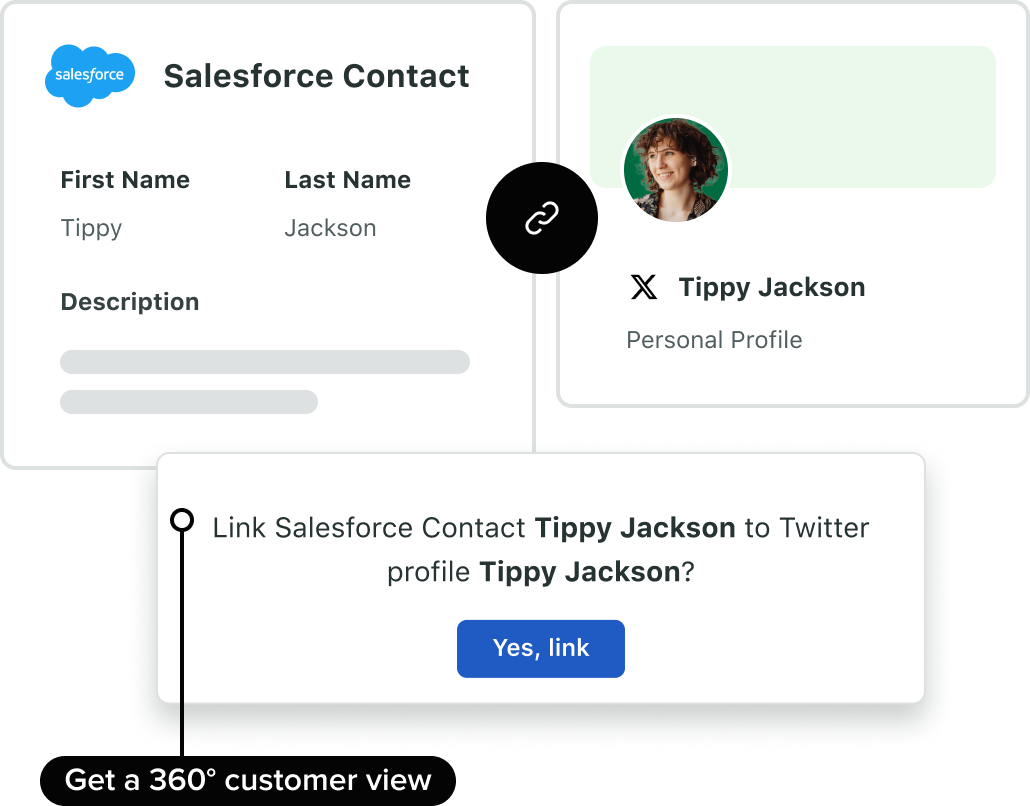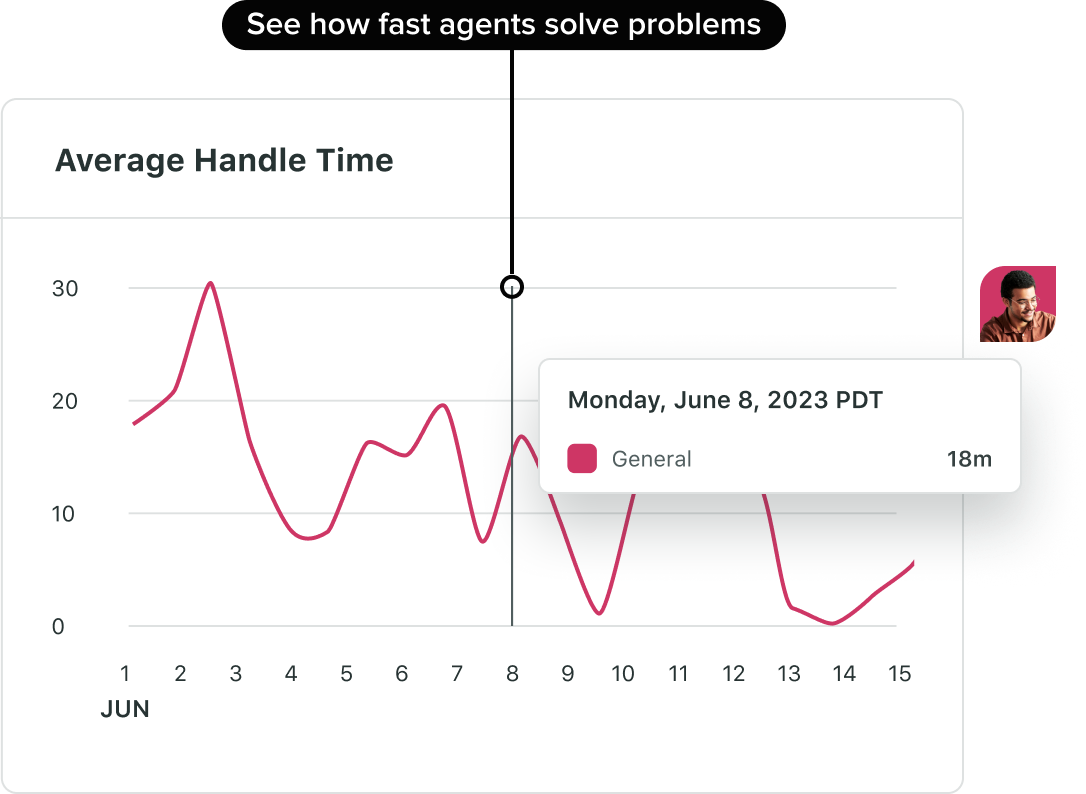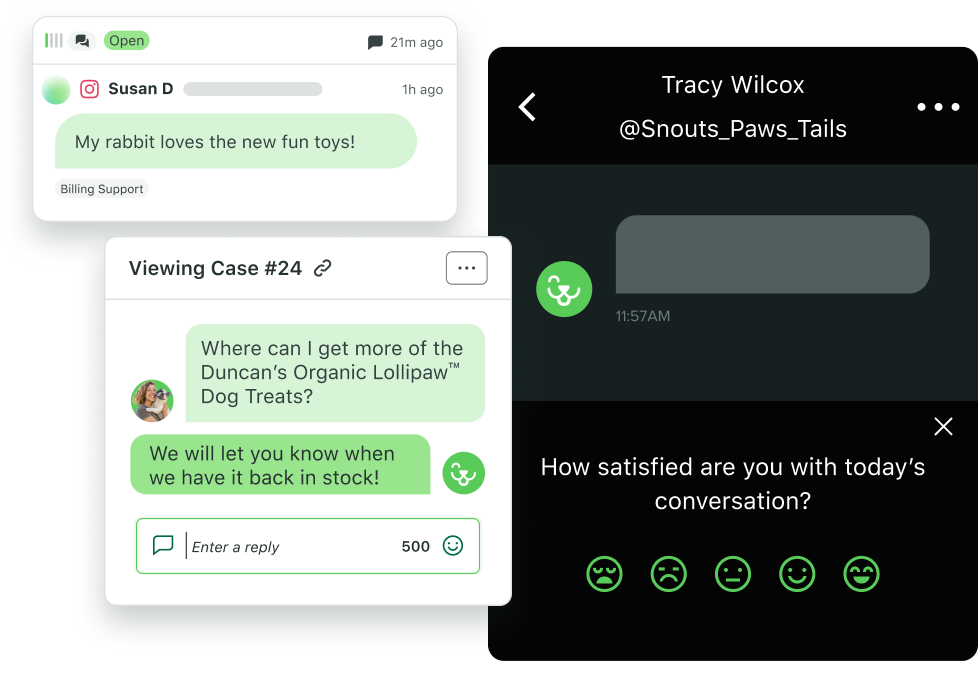
Social media customer service
Social media customer service: What it is and how to improve it
Reading time 17 minutes
Published on May 15, 2025

Table of Contents
Social media customer service has firmly established itself as a consumer expectation. Today, social comments sections, @-mentions and DMs are consumers’ preferred methods of reaching out for customer service. And they expect to be heard and attended to. According to The 2025 Sprout Social Index ™, 73% of social users agree that if a brand doesn’t respond to them on social, they’ll buy from a competitor.
This heightened expectation means the stakes are high for brands. They need to address customer needs with a level of personalized customer care that exceeds expectations.
Brands must be ready to tackle high-volume service events across Facebook, X, Instagram and more, and scale quickly and efficiently. But are you prepared to navigate the complex workflows that come with handling diverse customer inquiries across social platforms—each with its own rules and rhythms? If not, we’ve got the tips and tools to help you stay ahead.
In this guide, you’ll find insights to put the right strategy and tools in place to meet rising customer expectations and turn every interaction into a lasting brand loyalty moment.
What is social media customer service?
Social media customer service is the support you offer your customers across social networks like Facebook and Instagram. Customers can request assistance via DM, a review site or through their social posts. The time it takes to triage that request and respond appropriately is critical, especially in a competitive landscape where customers are spoiled for choice. It involves not just answering queries but actively listening and engaging with your audience. As the 2025 Sprout Social Index™ revealed, personalization isn’t just a nice-to-have; it’s the bedrock of customer loyalty in the modern social landscape.
Take this interaction between UPS and a customer. When the customer reached out to UPS over a delayed package, the brand responded promptly. They asked the customers to send a direct message with the tracking number, delivery address and email. They even signed off with a name. This simple, personalized touch reassures the customer they’re being heard—and that a real person is on the other side ready to help.
Responding promptly is as important as the support a brand provides. According to The 2025 Sprout Social Index™, nearly three-quarters of consumers expect a response within 24 hours or sooner. This data is consistent with what we found in our 2022 and 2023 Index research, showing customer care continues to be a critical component of customer loyalty.
Social customer care is all about proactively meeting your customers’ needs. This could mean a brand
- Has a self-service help center
- Educates customers about your product via social content
- Interacts with customers consistently (even before they make a purchase)
- Has answers and information on hand before someone reaches out
- Offers personalized service that goes beyond automated responses
Why is social media customer service important?
Social media is where your customers live—making it a key part of delivering standout customer care. They’re already asking questions, sharing feedback and starting conversations on platforms like Facebook, Instagram and X. Supporting them there means meeting them where they are, creating faster, easier and more natural interactions.
Social media customer service stats highlight how marketers are shifting their resources to scale social customer care via self-service tools, advanced social media tools, AI and automation. Here are three ways social customer care impacts your brand and makes it non-negotiable:
Boost customer loyalty
The 2025 Index shows consumers say companies should make personalized customer service their #1 social media priority. This isn’t surprising when you consider the real-time, conversational nature of social media platforms. They aren’t just for complaints—they’re for building relationships.
Proactive and attentive engagement transforms customer interactions into loyalty-building moments. It shows a brand values every customer’s voice and is committed to improving the user experience.
Here’s an example of how Sprout Social engaged with a customer who had questions about using the Sprout tool. We maintained an open, supportive conversation, ensuring they felt heard and fully equipped with the information they needed.
Increase brand awareness
When you engage positively with customers online, it’s not just a private interaction. These exchanges are often public, meaning hundreds, if not thousands, of other users have the potential to see each one. It’s a powerful form of indirect marketing that boosts brand awareness.
Social media usage stats show the amount of time internet users spend on social media is 141 minutes a day. A viral post or reply can quickly spiral into a wide-reaching discussion, putting your brand in front of eyes that might never have seen it otherwise.
Take Notion, for example. When an X user posted this, many chimed in with feedback.
Notion didn’t just view this from the sidelines—it responded with a message and a short video compilation.
Over 1,000 people viewed Notion’s response. The post, along with the response, was likely discussed further, creating a ripple effect that significantly increased Notion’s visibility and improved its brand image.
Enhance crisis management and response
Social customer care, when coupled with social listening tools that flag certain terms, improves your crisis management skills.
Here’s the truth: News, especially bad news, travels fast. People are more likely to post about negative experiences than positive ones in hopes of attracting a brand’s attention.
But a study also shows that nearly nine out of 10 people (88%) are more likely to look past a negative review if they see that the business responded and appropriately addressed the issue. By being present and responsive on these platforms, you can address concerns before they escalate.
Makeup brand Youthforia found itself in such a conundrum when it faced backlash over one of its foundation colours.
The apology did showcase Youthforia’s responsiveness and willingness to listen to customer feedback. However, the need for quick action further highlighted how crucial it is to have a ready crisis response deck in hand to maintain customer trust and manage a brand’s reputation at all times.
How to use social media for customer service
Social media is a powerful tool that enables brands to offer real-time interaction and personalized support to consumers. This enhances customer experience and brand loyalty. Here are some ways to use social media for customer care.
Monitor social channels
Keep an eye on platforms like X, Facebook, Instagram and LinkedIn for customer questions, comments or complaints. Tools like Sprout Social can help you actively track brand mentions, relevant keywords and hashtags across relevant platforms through Social Listening. This proactive approach ensures you’re aware of all conversations, even those where you aren’t directly tagged.
Engage promptly across platforms
When you engage across platforms quickly and consistently, it shows customers that your brand hears and values their concerns. This builds trust and demonstrates your brand’s commitment to excellent service. Sprout’s Smart Inbox helps you meet this need by centralizing messages from all your connected social profiles into one unified stream. This helps ensure social customer care teams don’t miss customer interactions, regardless of the platform.
If you manage a larger customer care team in a more traditional setup, Sprout’s Case Management helps you automate workflows and scale more efficiently. It automatically organizes and prioritizes incoming messages, routing them to the right team and providing real-time status updates. Cases get automatically created and routed by subject matter using Tags or numeric Case IDs to speed up issue resolution and ensure accurate workflow execution and faster triage.
Resolve issues publicly and privately
Responding promptly on social helps build your credibility and enables others to see that you’re accountable and responsive to customers. You can set up automated responses for frequently asked questions or common issues and then follow-up through direct messaging when necessary. Platforms like Sprout have collaboration capabilities, such as internal notes and case assignments, to further enable teams to work together seamlessly and avoid duplicate efforts.
Provide personalized responses
Everybody wants to be seen, and with a social customer care tool, you can ensure customized responses to every customer. For example, Sprout Social’s comprehensive customer profiles provide you with valuable context about past interactions, preferences and customer sentiment. This enables social customer care teams to deliver more personalized and effective support.
11 tips for providing good social customer service
Delivering great customer service on social media goes beyond quick replies—it’s about building trust, showing empathy and creating meaningful connections. Whether you’re just getting started or looking to improve, these 11 tips will help you elevate your social customer service game.
Bonus: Great customer service strategies aren’t built in a vacuum. Use this free social media customer service training deck to align marketing and service teams around a defined set of shared goals.
1. Use a social media customer service tool
A social media customer service tool enables you to manage and respond to customer inquiries across multiple platforms from one central dashboard. It streamlines communication, ensures no message gets missed and enables faster, more efficient support. Plus, marketing, sales and service teams can collaborate seamlessly by tracking conversations, analyzing sentiment and managing workflows in one place. They can also send cases across different teams to best serve customer needs.
For example, with Social Customer Care by Sprout Social, you can monitor and respond to customer inquiries armed with analytics to track your customer service performance. You also have a centralized social inbox removes the need to switch between different social media platforms.. There are important tools that enable you to ensure smoother workflows and expedite manual tasks so you’re able to spend more time focused on creating moments that matter with your customers.
With Suggestions by AI Assist in Sprout, you can further enhance your tone of voice, making it more professional or friendly, to match that of the customer. Plus, Salesforce users can use Sprout’s Salesforce integration to connect social media interactions with more data and insights for a full 360 customer view.

Care by Sprout empowers teams to accelerate customer service workflows to triage, classify and route social cases effectively. Piece together disjointed insights and conversations across different channels to organize and prioritize incoming messages by subject matter using tags.
Scale your workflows with Automatic Case Creation based on your criteria, such as topic, profile type, message type, follower count, VIP status, language, sentiment and keyword, defined in automated rules. Teams can prioritize urgent or important cases with assignments and internal conversations to view ticket status and priority, as well as to understand what customer questions are already being addressed.

Along with workflow management, Social Customer Care by Sprout Social helps you drive business growth through clear analytics and shareable reporting that can help you measure the impact of your care team. Track productivity as your team responds to incoming messages and optimize workflows for increased customer satisfaction with the Case Management Report. Plus, get visibility into individual agent activities so you can surface opportunities for agents to improve performance. Thus, strengthening guidance for career development and leading to an overall enhanced customer experience.

2. Conduct a social customer service audit
Making changes just for the sake of it won’t get you far. To truly improve your social media customer service, start with a thorough social media audit to identify what’s working well and where there’s room for improvement.
A SWOT analysis can provide meaningful insights into where and how you can improve. What about your process is going well? Where are there roadblocks or bottlenecks? A candid conversation with your team will reveal where changes can be made.
For example, if you’re managing a high volume of messages split across multiple networks, it may be time to use Cases. The tool enables you to consolidate social conversations across major social networks and review sites to efficiently manage customer inquiries at scale.

3. Improve customer response time
To meet customer expectations effectively, it’s crucial to understand your current performance levels. One key metric to track is your social media response time. By setting specific goals for improvement, you can make significant strides in customer satisfaction. If you’re looking for tips on how to get this done, you’re welcome to refer to our strategy.
Sprout’s social media team looked closely at our Case Management Report to view metrics like Average Handle Time. This helped identify a clear opportunity to improve our average time to action during designated customer support hours.

By further analyzing our platform data and reflecting on our existing workflows, our team realized that strengthening the connection between our social media efforts and broader customer support processes could lead to major improvements.
By resetting expectations and establishing centralized ownership for social support, we achieved quick and dramatic results. In only three months, we managed to reduce our average time to action by up to 55% during the periods we targeted for improvement.
4. Create an internal tracking system
Great customer service doesn’t stop at resolving individual issues—it fuels a feedback loop that drives improvements across your business. To make the most of this, set up an internal tracking system that captures recurring problems, such as shipping delays or product defects, and flags them for company-wide action. Your system should also include the ability to tag, categorize and prioritize issues, as well as track resolution times and customer sentiment.
Generating regular reports will help you assess whether your service strategy is working and where to optimize. It doesn’t have to be complex—a well-organized spreadsheet or a simple ticketing system can be a strong starting point.
The Tag feature in Sprout enables you to tag incoming messages with any created tag, such as “feature request” or “product complaint.” This way, you can quickly run a report on these tags to see what’s trending.

Every social media customer service report you generate should track key metrics like response time and, if available, customer satisfaction ratings. This ongoing feedback loop helps you identify areas for improvement and consistently raise the bar for service quality.

By staying closely attuned to customer experiences on social media, you can eliminate outdated data, stay agile and make smarter, more informed decisions.
5. Personalize canned responses to increase customer engagement
The most important thing you can do as a brand is to make your customers feel like you’re listening and addressing their unique needs and preferences.
Empathetic, personalized customer service builds trust, increases customer engagement and improves customer retention.
At the same time, crafting replies from scratch isn’t sustainable especially when it’s a balancing act between different channels. You have to create canned responses—saved messages support reps can roll out when responding to customers. These replies cover anything from general “thank yous” to specific concerns.
Luckily, AI capabilities such as Suggested Replies in social media management tools like Sprout automatically understand the context of an incoming message and help speed up social customer care while still infusing every response with your personality.
You can also use Sprout’s Enhance by AI Assist feature, where AI takes on the heavy lifting of creating friendly or professional-sounding customer responses to ensure a personalized customer service experience.
6. Standardize your brand’s social customer service voice
You want your social approach to be cohesive across promotions, posts and service responses. It’s possible to have a fun attitude for original posts and a more conciliatory tone for customer complaints. Starbucks follows this friendly route and incorporates conversational cues directly from their audience.
However, when multiple team members manage social media customer care, it becomes easier for your brand voice to get diluted, especially as your team grows. That’s where Sprout’s Saved Replies can help your team respond quickly and consistently while staying true to your brand tone.

However you approach maintaining a seamless brand voice, document and create a brand voice strategy, so everyone on your team knows how to represent the brand on social media.
7. Document an escalation management strategy
Close to 80% of customers expect consistency in customer service interactions and 55% wish issue resolutions were smooth instead of a ping pong match between separate departments. There are times when an issue isn’t as straightforward due to various protocols involved. However, this may not be transparent to the consumer. These instances call for having an escalation management strategy in place so that customer care teams are always ready.
United Airlines faced such a situation but handled it with care and diplomacy.
8. Uncover crucial customer conversations with monitoring and listening
A social customer service strategy must include social listening. With so many conversations happening via social, keeping track of every mention is often chaotic. That’s why so many brands today rely on monitoring and listening tools to uncover:
- Brand mentions that aren’t directly @tagged (or misspelled brand mentions)
- Competitor mentions related to your business, such as call-outs or comparisons
- Compliments and shout-outs that could result in more positive customer sentiment
Listening is also invaluable for uncovering your customers’ frequently asked questions. Here’s a word cloud from Sprout Social Listening that visualizes the top keywords, mentions, emoticons and hashtags found for a specified topic:

For example, customer service metrics may show an uptick in volume about a specific feature or bug. You may realize that customers are stuck on the same few product features or questions. Tracking these changes via listening and writing canned responses is a win-win for your social team.
Gathering voice of customer data gives you a more comprehensive understanding of what your customers want and need. A listening tool makes the process much easier.
Proactive and efficient customer service on social is no longer a nice-to-have; it’s a critical driver of brand perception and loyalty. The latest data on customer engagement on social media highlights just how integral advanced customer care is to a modern brand strategy.
9. Learn from negative feedback
Customer care conversations can be a great resource for learning and unlearning. Negative feedback can be a goldmine of information that refines your product, service and customer interactions. The next course of action is to understand product or service gaps and use those opportunities for improvement.
Consider Dove. When a customer shared that they often run out of body wash due to the lack of a larger bottle size, Dove responded by thanking them and assuring their feedback would be passed along to the product team.
10. Use AI
AI in customer service enhances social customer care by enabling faster, more efficient interactions. AI-powered suggestions and automated messaging systems help brands handle common inquiries instantly and provide customers with quick responses around the clock. Advanced sentiment analysis tools help brands understand the emotions behind customer messages, so teams can prioritize urgent issues and tailor their responses. AI algorithms also analyze previous interactions to suggest responses tailored to individual customer needs and preferences.
Here are some examples of how AI and automation are integrated within Sprout’s customer care solution to enhance customer experience and empower care teams.
Enhance by AI Assist
Suggests different stylistic tones for your replies within the Smart Inbox and Cases, helping agents craft more empathetic or professional responses as needed. When responding to customer service cases, AI algorithms recommend alternative replies to enhance the tone of voice or provide more elaborate responses, saving agents time and ensuring brand consistency.
Summarize by AI Assist
Helps care teams generate summaries of long customer messages, including private messages, so agents can quickly grasp the context and key issues.
Sentiment analysis
Analyzes incoming messages and categorizes them as positive, negative or neutral. This helps customer care teams prioritize urgent or negative feedback and tailor their responses accordingly. This capability also powers Smart Inbox message filtering.
Automated Case Management
AI and automation create cases from social messages that require a response and route them to relevant teams or individuals based on predefined criteria such as a topic, sentiment or keywords. This streamlines workflows and ensures no customer inquiry is overlooked.
Message Intent Classification
Helps care teams identify and prioritize the most urgent customer messages, ensuring that critical issues are addressed first.
Analyze by AI Assist in Social Listening
Helps customer care teams by identifying emerging issues and trends in customer conversations, which in turn enables proactive intervention.
Customer Profiles with AI Insights
Sprout Social’s customer profiles compile past interactions and sentiment so agents have context to personalize their support. AI algorithms contribute to understanding the customer’s history and potential needs.
11. Provide support in multiple languages
To provide support in multiple languages means connecting with customers in their native or preferred language. This makes your service more accessible and inclusive. Without this effort, brands risk isolating a large group of potential customers who may feel overlooked or misunderstood due to language barriers.
Booking.com, for example, wasted no time in responding to this query in Spanish:
By ensuring language isn’t a barrier, Booking.com provides a truly global service.
Four tips to improve multilingual support:
- Understand cultural nuances: Language is deeply tied to culture. Train your team to understand cultural nuances, expressions and etiquette to avoid misunderstandings and provide respectful service.
- Employ multilingual staff: Hire customer service representatives who are fluent in the languages your customers speak. This ensures clear, accurate and culturally relevant communications.
- Use translation tools: Leverage technology such as AI-powered translation tools to provide accurate and instant translations. Ensure you regularly update these tools for quality and context.
- Create localized content: Provide FAQs, guides and support content in multiple languages. This provides a way to preempt common questions and offer self-service options to customers worldwide.
Social media customer service examples that inspire
We’ve covered the fundamentals of exceptional social media customer service. Now let’s explore some real-world examples. Here are five brands that have excelled in building lasting customer relationships through social media.
1. Marks and Spencer
Marks and Spencer’s social customer service stands out for its conversational and personable approach. The brand lets its personality shine by using language that friends might use in a natural setting. For example, in a complaint regarding one of their pizzas, M&S starts with “Oh no!”, and adds emojis to express empathy and lighten the mood.
2. PNC Bank
Businesses operating within highly regulated industries face unique challenges when providing customer service on social media. A rogue response can lead to more than just a frustrated customer—it can also cause problems with regulatory agencies.
That said, these organizations can still innovate to meet audience expectations. Just look to PNC Bank’s social media customer service strategy.
PNC Bank is proactive in its approach to social media customer service and often reaches out to customers to see how it can assist. This makes it easy for users to escalate issues as needed, and enables the brand to do its best to resolve issues without sending customers to a different channel.
According to Sprout Social Listening data from January 13 to February 12, 2024, PNC Bank boasts a 64% positive sentiment rate, which is 8% and 12% higher than its biggest competitors.
3. Aldi Australia
Aldi Australia is known for always being prompt in engaging with customers and addressing their inquiries. They encourage online engagement for efficient assistance and often direct customers to their centralized customer support line and other sources of information, such as newsletters and stock availability forms.
4. Microsoft Azure
Microsoft Azure delivers strong social media customer service by offering clear, technical guidance tailored to IT professionals. They monitor platforms like X to quickly address issues, clarify documentation and share relevant updates. The brand’s social customer care team provides precise, solution-driven help that reflects deep product knowledge. This technical expertise and prompt responsiveness promotes them further as a reliable partner for enterprise users navigating complex cloud environments.
5. Sephora
Makeup brand Sephora is known for its customer promotions and social media customer service. They provide prompt, personalized responses across platforms like X and Instagram. Their team actively engages with customers, offers product recommendations, addresses inquiries and resolves issues with a friendly and professional tone.
By maintaining a consistent brand voice and responding quickly, like the example below, Sephora creates a positive, interactive experience that strengthens customer loyalty and trust.
Modernize your approach to social media customer service
Social media is the most accessible touchpoint for customers today. It’s a suggestion box, customer service desk and call center—all in one. Modernize and automate your social media customer service to meet consumers’ evolving expectations.
Sprout Social uses AI to analyze customer sentiment, predict service needs and personalize interactions, significantly enhancing response quality and speed. With advanced tools like this, your team can focus on strategy and building stronger customer relationships.
Try Care by Sprout and give your teams the resources to provide quality customer service.
Request a 30-day Free Trial of Care by Sprout Social
Social media customer service FAQs
How to provide good customer service on social media?
Start with being responsive, approachable and empathetic. Monitor your channels closely to catch customer inquiries or complaints early, and aim to respond quickly—ideally within a few hours. Personalize your replies by addressing customers by name and tailoring your responses to their specific concerns. Stay professional and positive, even when handling difficult situations, and know when to move sensitive conversations to private messages. Consistency across platforms, proactive communication and a genuine focus on resolving issues help build trust and strengthen your brand’s reputation online.
What is a good social media customer service job description?
A good social media customer service job description includes responding to customer inquiries, resolving issues professionally and maintaining the brand’s voice across platforms. It emphasizes strong communication skills, quick problem-solving and experience with social media and CRM tools.
How to handle social media customers?
Handle social media customers effectively, respond quickly, listen carefully and maintain a friendly, professional tone. Personalize your replies, address concerns openly and move sensitive conversations to private channels when needed. Always stay calm, show empathy and focus on resolving issues to leave customers feeling heard and valued.
Additional resources for Social media customer service
Social media customer service: What it is and how to improve it
How to balance speed and quality customer service
Prepping your social customer care team for the holiday rush with Sprout
Social media customer service statistics to know in 2025
How customer relationship marketing on social media drives revenue
Social customer care is a team sport—are you all in?
How to build customer relationships with social media
Elevate your support with social media customer service software































Share